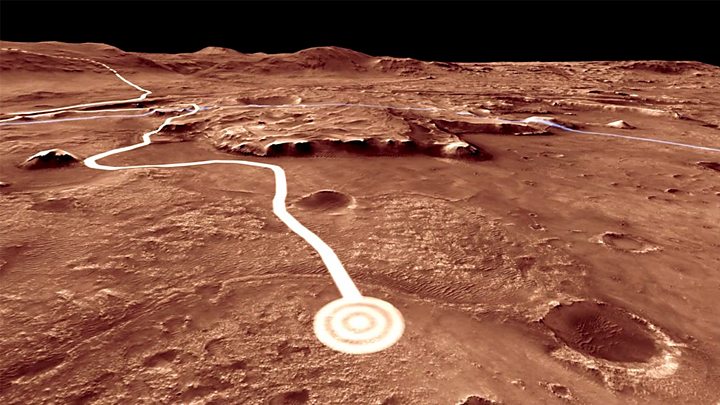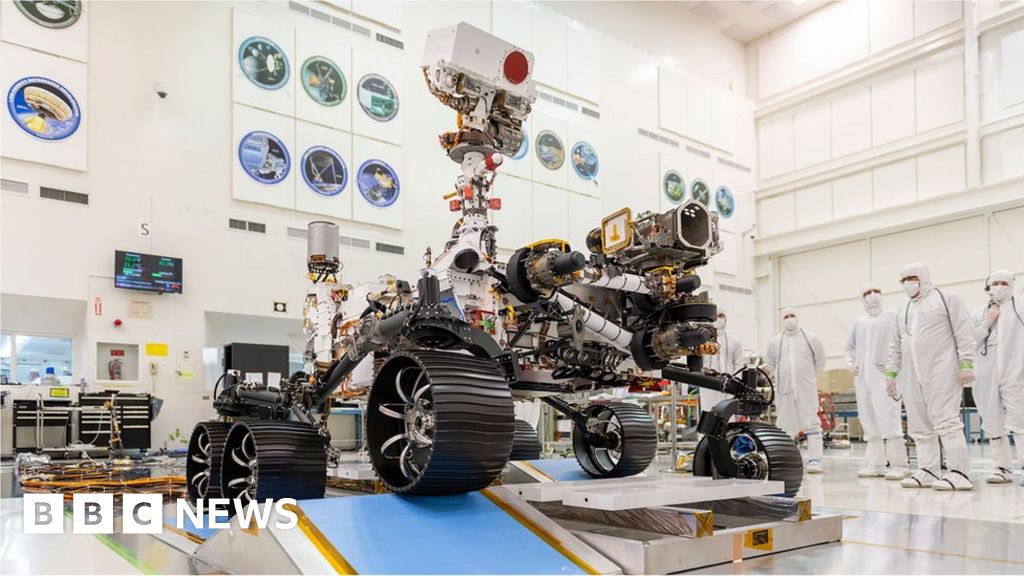 Image copyright
Image copyright
NASA / JPL-Caltech
On 20 July, Nasa will bring collectively its first different to initiate the Perseverance rover to Mars. Here, we reply some trendy questions about the mission.
What is going to the rover contrivance?
The Perseverance rover will land on Mars to search out indicators of past microbial lifestyles, if it ever existed. This might perhaps occasionally perhaps very nicely be the main Nasa mission to hunt straight for these “biosignatures” for the reason that Viking missions in the 1970s.
The rover will rating samples of rock and soil, encase them in tubes, and leave them on the planet’s flooring for return to Earth at a future date. Perseverance would perhaps also explore Martian geology and take a look at out a skill for future astronauts to manufacture oxygen for breathing and gas from CO2 in the ambiance.
Moreover, a drone-like helicopter will seemingly be deployed to indicate the main powered flight on Mars. Perseverance will explore Mars’ Jezero Crater for no longer lower than one Martian one year (about 687 Earth days).
How does it bring collectively to Mars?
Image copyright
NASA / C. MANGANO
The rover is encapsulated within an aeroshell, consisting of a backshell and heatshield
The one-tonne, automobile-sized rover is scheduled to initiate from Cape Canaveral Air Power Station in Florida on an Atlas 5 rocket between 20 July and 11 August 2020. Perseverance travels to Mars enclosed in a protective aeroshell consisting of two ingredients: a conical backshell and a zigzag heat defend.
The aeroshell is related to a cruise stage that fires thrusters to attend the spacecraft heading in the suitable route, guaranteeing it arrives at Mars in the actual net site for touchdown. Perseverance will manufacture its seven-minute descent to the Martian flooring on 18 February 2021.
The relative positions of Earth and Mars mean that initiate alternatives advance up handiest every 26 months. If Perseverance didn’t initiate to Mars this summer season, the mission would bear to wait unless September 2022 to take grasp of a look at again.
Technical specs: Perseverance rover
- Measurement: 3m (10feet)
- Width: 2.7m (9ft)
- Height: 2.2m (7ft)
- Weight: 1,025kg (2,260lbs)
- Energy supply: Multi-Mission Radioisotope Thermoelectric Generator (MMRTG). Converts heat from the radioactive decay of plutonium into electricity
How does Perseverance land?
Image copyright
NASA / JPL-Caltech
Artwork: The skycrane manoeuvre is designed to lower the rover on to the bottom safely
When the spacecraft approaches the Martian ambiance it is travelling at speeds of around 21,000 km/h (13,000 mph). As it encounters superheated gases, the temperature of the heat defend peaks at 2,100C (3,800F). When the spacecraft reaches 11km (7mi) above the bottom, a parachute deploys, slowing it to below 10% of its popular spin.
The warmth defend drops a long way off from the backshell and, for a transient while, the rover – which is hooked as much as a descent stage – falls freely towards the bottom.
Eight retrorockets on the descent stage then fireplace, permitting the “sky crane” manoeuvre to be performed. Perseverance is diminished slowly on three nylon ropes and an “umbilical twine”. When the rover’s wheels touch the bottom, the tethers are severed and the descent stage flies to a valid distance.
The place on Mars will or no longer or no longer it’s exploring?
Image copyright
NASA / JPL-Caltech / MSSS / JHU-APL/ESA
Jezero Crater on Mars: The rover’s touchdown ellipse is marked by the black circle
The rover’s map is a 49km (30 mi) -wide affect depression subtle north of Mars’ equator. Extra than 3.5 billion years previously, scientists mediate, river channels spilled over the wall of Jezero Crater to manufacture a lake.
The shining bowl would perhaps be home to considered one of basically the most efficient preserved Martian examples of a delta, a sedimentary structure that kinds when rivers enter inaugurate our bodies of water and deposit rocks, sand and – potentially – organic carbon in layers.
Image copyright
NASA/JPL/JHUAPL/MSSS/BROWN UNIVERSITY
Jezero’s delta is considered one of basically the most efficient preserved examples on Mars
Microbes might perhaps perhaps bear lived in the crater when water became there. Jezero preserves a file of main geological processes similar to affect cratering and volcanism, as well to the action of water. Studying its rocks will clarify how the planet developed over time.
How does the rover think for indicators of past lifestyles?
Jezero’s fan-fashioned delta is considered one of many prime targets seeking indicators of past lifestyles. Scientists also search carbonate minerals deposited across the crater’s shoreline like the ring in a bathtub. When carbonates precipitate out of water, they can trap issues that are in it, including evidence of lifestyles.
Image copyright
Science Describe Library
Stromatolites in Shark Bay, Australia
“We’ll be trying to search out biosignatures – patterns, textures or substances that require the affect of lifestyles to manufacture,” says deputy challenge scientist Katie Stack Morgan.
We don’t know what Martian biosignatures might perhaps perhaps appear to be, however the popular Earth might perhaps perhaps supply clues. A file of our planet’s early lifestyles might perhaps perhaps very nicely be found in stromatolites, rocks in the starting up fashioned by the expansion of layer after layer of micro organism. If same structures exist on Mars, scientists might perhaps perhaps mix measurements from varied devices to evaluate the likelihood of a biological origin.

Media playback is unsupported in your software program
Why contrivance scientists mediate there might perhaps perhaps bear been lifestyles on Mars?
This day, Mars is frigid and dry, with a thin ambiance that exposes the flooring to execrable ranges of cosmic radiation. However billions of years previously, the planet appears to bear been wetter, with a thicker ambiance. A pair of lines of evidence, such because the presence of mudstones and sedimentary bands, show that there became as soon as liquid water on the flooring.
Here is famous because water is an needed ingredient for all lifestyles on Earth. Curiosity also found organic molecules preserved in three-billion-one year-popular sedimentary rocks. While tantalising, or no longer it’s no longer determined whether these organics retract a file of popular lifestyles, were their food, or don’t bear anything to contrivance with biological processes.
What devices is the rover carrying?
Image copyright
NASA / JPL-Caltech
Perseverance is carrying an evolved payload of science devices to rating facts about Mars’ geology, ambiance, environmental prerequisites and doable biosignatures:
- Mastcam-Z: An evolved camera machine to attend explore flooring minerals
- MEDA: A Spanish-constructed sensor suite to measure temperature, wind spin and route, stress, humidity and dirt
- MOXIE: Experiment to indicate how astronauts might perhaps perhaps manufacture oxygen from Martian CO2 for breathing and gas
- PIXL: Has an X-ray spectrometer to title chemical ingredients and a camera that takes shut-up images of rock and soil textures
- RIMFAX: A Norwegian-constructed ground-penetrating radar that can map geology under the flooring at centimetre scales
- SHERLOC: Will employ spectrometers, a laser and camera to hunt for organics and minerals that were altered by water
- SuperCam: Will inspect rock and soil with a camera, laser and spectrometers to search for organic compounds
Why wing a helicopter on Mars?
Image copyright
NASA / JPL-Caltech
Ingenuity is a 1.8kg (4lb) helicopter that can bolt to Mars related to the abdominal of Perseverance. Nasa needs to indicate powered flight in Mars’ thin ambiance. The Crimson Planet’s gravity is lower (about one-third that of Earth’s), however its ambiance is subtle 1% the density of Earth’s. This makes it more challenging to generate the rob required to bring collectively off the bottom.
Outfitted with two counter-rotating blades, the independent helicopter can take grasp of colour images with a 13-megapixel camera, the same kind recurrently found in smartphones. Rotorcraft might perhaps perhaps very nicely be a helpful map to explore other worlds: flying vehicles crawl sooner than ground-primarily based fully rovers, and might perhaps perhaps reach areas that are inaccessible to wheeled vehicles.
How does this rover vary from Curiosity?
Image copyright
NASA / Kim Shiflett
The wheels bear been re-designed to manufacture them extra resistant to wear and walk
Perseverance is extraordinarily akin to its predecessor Curiosity in the case of general manufacture, however there are key variations. As nicely because the original science payload, Perseverance has a bigger “hand”, or turret, on the pause of its robotic arm to attend a heavier suite of tools, including a coring drill.
The machine designed to cache samples would perhaps be a brand original characteristic. Engineers bear re-designed the rover’s wheels to manufacture them extra resistant to wear and walk. Curiosity’s wheels sustained damage from using over piquant, pointed rocks.
How does the rover retailer rocks and soil?
The rover’s Sample Caching Machine is serene of three robotic ingredients. Essentially the most visible is the two.1m (7ft) -prolonged, 5-jointed robotic arm, which is bolted to the chassis. A rotary percussive drill on the arm’s turret is ready to carve out intact cores of Martian rock. These cores – about the scale of a fragment of chalk – spin true into a sample tube. The major robot arm then places the stuffed tube on a mechanism at the front of the rover called the bit carousel.
This mechanism, which recollects a 1960s journey projector, strikes the tube right by means of the rover the place a smaller, 0.5m (1.6ft) -prolonged sample facing arm (fundamentally is named the T. rex arm) grabs it. An image is taken earlier than the tube is hermetically sealed and placed in a storage rack. It’s driven around on the rover unless the personnel finds an true net site to drop it off.
How will the Martian samples be brought to Earth?
Image copyright
ESA / ATG Medialab
Artwork: The plot foresees a “obtain” rover being despatched to rating the sample containers
For decades, scientists bear needed to utter samples of Martian rock and soil to Earth for explore in laboratories. Here, scientists might perhaps perhaps investigate the samples with devices too shining and intricate to ship to Mars. By leaving rock and soil samples on the flooring in sealed tubes, Perseverance will lay the groundwork for that to happen.
As phase of the programme is named Mars Sample Return, a separate mission will seemingly be sent to land on Mars to acquire up the tubes using a “obtain” rover. A robotic arm will then transfer the tubes from the obtain rover true into a rocket called the Mars Ascent Automotive (MAV). The ascent automobile blasts the samples into Martian orbit the place they’re captured by an orbiter. This orbiter will then utter the sample containers to Earth, perhaps by 2031.
Discover Paul on Twitter.
